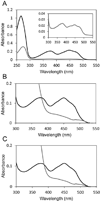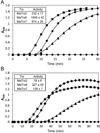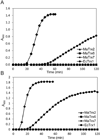Molecular characterization of the thioredoxin system from Methanosarcina acetivorans
- PMID: 25112424
- PMCID: PMC4199913
- DOI: 10.1111/febs.12964
Molecular characterization of the thioredoxin system from Methanosarcina acetivorans
Abstract
The thioredoxin system, composed of thioredoxin reductase (TrxR) and thioredoxin (Trx), is widely distributed in nature, where it serves key roles in electron transfer and in the defense against oxidative stress. Although recent evidence reveals Trx homologues are almost universally present among the methane-producing archaea (methanogens), a complete thioredoxin system has not been characterized from any methanogen. We examined the phylogeny of Trx homologues among methanogens and characterized the thioredoxin system from Methanosarcina acetivorans. Phylogenetic analysis of Trx homologues from methanogens revealed eight clades, with one clade containing Trxs broadly distributed among methanogens. The Methanococci and Methanobacteria each contain one additional Trx from another clade, respectively, whereas the Methanomicrobia contain an additional five distinct Trxs. Methanosarcina acetivorans, a member of the Methanomicrobia, contains a single TrxR (MaTrxR) and seven Trx homologues (MaTrx1-7), with representatives from five of the methanogen Trx clades. Purified recombinant MaTrxR had 5,5'-dithiobis(2-nitrobenzoic acid) (DTNB) reductase and oxidase activities. The apparent Km value for NADPH was 115-fold lower than that for NADH, consistent with NADPH as the physiological electron donor to MaTrxR. Purified recombinant MaTrx2, MaTrx6 and MaTrx7 exhibited dithiothreitol- and lipoamide-dependent insulin disulfide reductase activities. However, only MaTrx7, which is encoded adjacent to MaTrxR, could serve as a redox partner to MaTrxR. These results reveal that M. acetivorans harbors at least three functional and distinct Trxs, and a complete thioredoxin system composed of NADPH, MaTrxR and at least MaTrx7. This is the first characterization of a complete thioredoxin system from a methanogen, which provides a foundation to understand the system in methanogens.
Keywords: anaerobe; archaea; methanogen; thioredoxin; thioredoxin reductase.
© 2014 FEBS.
Figures





Similar articles
-
The Methanosarcina acetivorans thioredoxin system activates DNA binding of the redox-sensitive transcriptional regulator MsvR.J Ind Microbiol Biotechnol. 2015 Jun;42(6):965-9. doi: 10.1007/s10295-015-1592-y. Epub 2015 Mar 20. J Ind Microbiol Biotechnol. 2015. PMID: 25791378 Free PMC article.
-
Methanosarcina acetivorans utilizes a single NADPH-dependent thioredoxin system and contains additional thioredoxin homologues with distinct functions.Microbiology (Reading). 2017 Jan;163(1):62-74. doi: 10.1099/mic.0.000406. Epub 2017 Feb 8. Microbiology (Reading). 2017. PMID: 27902413 Free PMC article.
-
Enzymatic characterization of five thioredoxins and a thioredoxin reductase from Myxococcus xanthus.FEMS Microbiol Lett. 2024 Jan 9;371:fnae058. doi: 10.1093/femsle/fnae058. FEMS Microbiol Lett. 2024. PMID: 39038987
-
The thioredoxin system and cancer therapy: a review.Cancer Chemother Pharmacol. 2019 Nov;84(5):925-935. doi: 10.1007/s00280-019-03912-4. Epub 2019 Jul 31. Cancer Chemother Pharmacol. 2019. PMID: 31367788 Review.
-
Role of thioredoxin in lung disease.Pulm Pharmacol Ther. 2012 Apr;25(2):154-62. doi: 10.1016/j.pupt.2012.01.002. Epub 2012 Jan 25. Pulm Pharmacol Ther. 2012. PMID: 22293327 Review.
Cited by
-
A Novel F420-dependent Thioredoxin Reductase Gated by Low Potential FAD: A TOOL FOR REDOX REGULATION IN AN ANAEROBE.J Biol Chem. 2016 Oct 28;291(44):23084-23100. doi: 10.1074/jbc.M116.750208. Epub 2016 Sep 2. J Biol Chem. 2016. PMID: 27590343 Free PMC article.
-
Crystal Structure of the Apo-Form of NADPH-Dependent Thioredoxin Reductase from a Methane-Producing Archaeon.Antioxidants (Basel). 2018 Nov 17;7(11):166. doi: 10.3390/antiox7110166. Antioxidants (Basel). 2018. PMID: 30453601 Free PMC article.
-
Toward a mechanistic and physiological understanding of a ferredoxin:disulfide reductase from the domains Archaea and Bacteria.J Biol Chem. 2018 Jun 15;293(24):9198-9209. doi: 10.1074/jbc.RA118.002473. Epub 2018 May 2. J Biol Chem. 2018. PMID: 29720404 Free PMC article.
-
Metabolic shift at the class level sheds light on adaptation of methanogens to oxidative environments.ISME J. 2018 Feb;12(2):411-423. doi: 10.1038/ismej.2017.173. Epub 2017 Nov 14. ISME J. 2018. PMID: 29135970 Free PMC article.
-
The Methanosarcina acetivorans thioredoxin system activates DNA binding of the redox-sensitive transcriptional regulator MsvR.J Ind Microbiol Biotechnol. 2015 Jun;42(6):965-9. doi: 10.1007/s10295-015-1592-y. Epub 2015 Mar 20. J Ind Microbiol Biotechnol. 2015. PMID: 25791378 Free PMC article.
References
-
- Meyer Y, Buchanan BB, Vignols F, Reichheld JP. Thioredoxins and glutaredoxins: unifying elements in redox biology. Annual review of genetics. 2009;43:335–367. - PubMed
-
- Lu J, Holmgren A. The thioredoxin antioxidant system. Free radical biology & medicine. 2014;66:75–87. - PubMed
-
- Arner ES, Holmgren A. Physiological functions of thioredoxin and thioredoxin reductase. Eur J Biochem. 2000;267:6102–6109. - PubMed
-
- Lillig CH, Holmgren A. Thioredoxin and related molecules--from biology to health and disease. Antioxid Redox Signal. 2007;9:25–47. - PubMed
-
- Williams CH, Arscott LD, Muller S, Lennon BW, Ludwig ML, Wang PF, Veine DM, Becker K, Schirmer RH. Thioredoxin reductase two modes of catalysis have evolved. Eur J Biochem. 2000;267:6110–6117. - PubMed
Publication types
MeSH terms
Substances
Grants and funding
LinkOut - more resources
Full Text Sources
Other Literature Sources
Molecular Biology Databases

